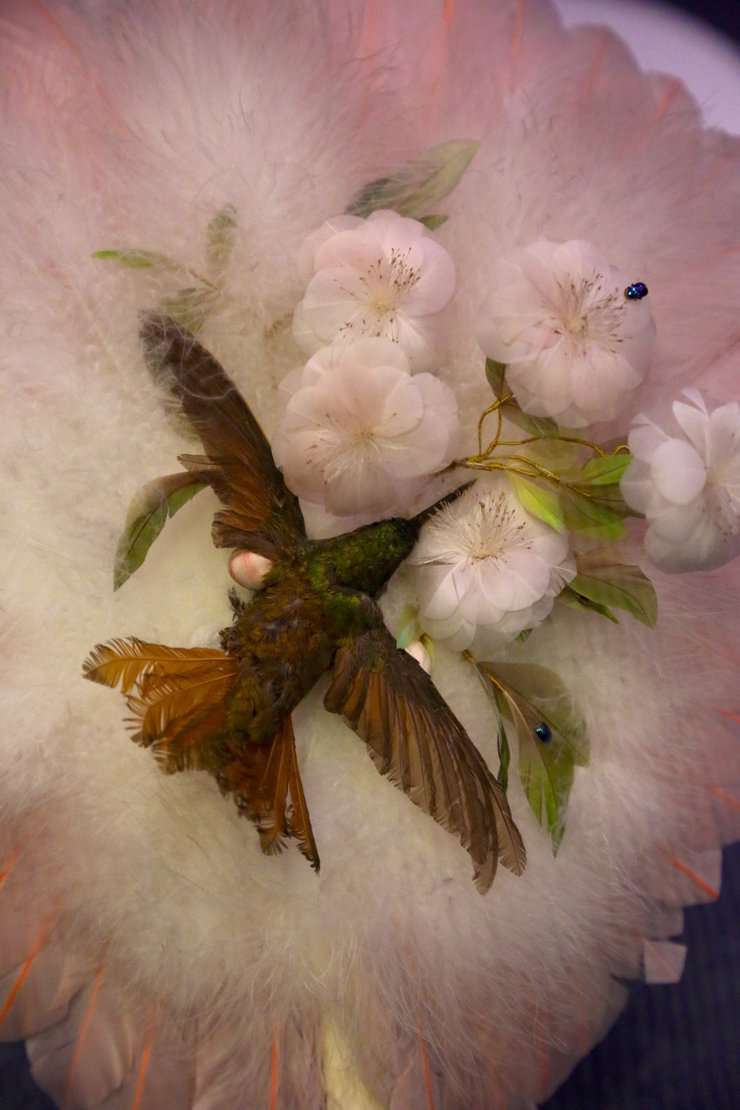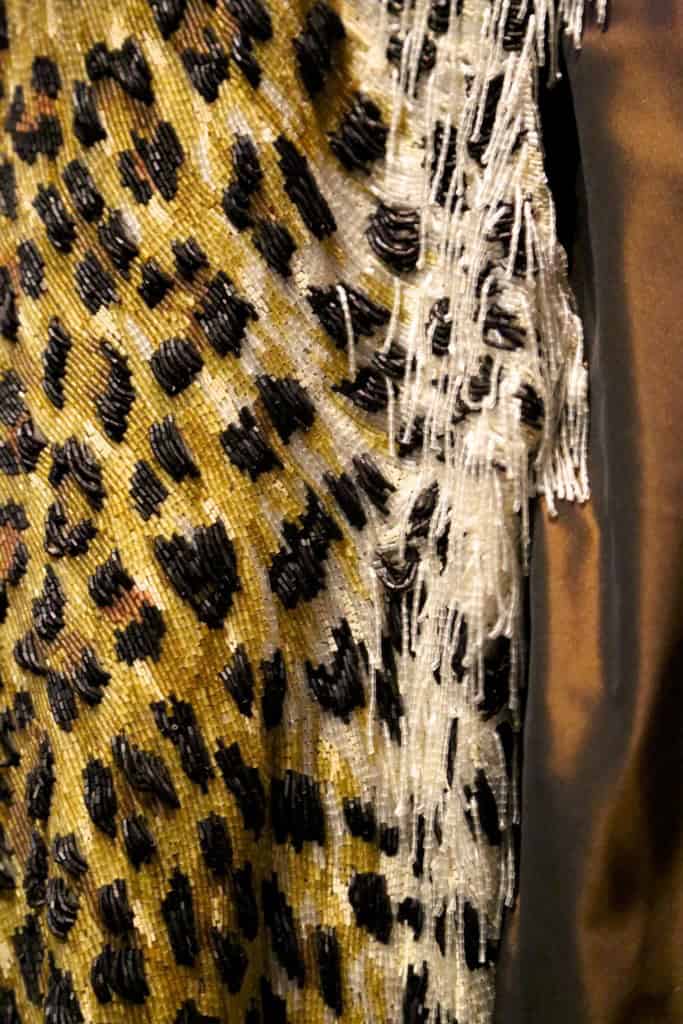
Fashioned from Nature
An inspirational exhibition has opened at the Victoria and Albert Museum. Which traces the complex relationship between fashion and nature from its historic roots to visions for the future. It eloquently explores 400 years of the inspiration fashion has had on the materials and processes of fashion design. The above fan features a real hummingbird and is dated from the 1880’s and was probably made my Miles M. & E. Natte in Rio de Janeiro. The underlying turkey feathers are dyed a subtle shade of pink, and contrast with green parrot, jewel beetles and bone.



The centrepiece of the show is a dress designed by Calvin Klein innovatively constructed of fabric created from recycled plastic bottles. Which Emma Watson wore to the Metropolitan Museum Gala in New York in 2016.
The curator Edwina Ehrman has brought over 30 years of experience curating fashion into this outstanding exhibition. In an exclusive interview with IRK Magazine revealed how few books about fabrics had pollution in the index. She thought that it was something that needed to be changed. She recounted how one person described her as being really brave to confront the issues. Which motivated her to achieve a light touch, whereby people could have an enjoyable experience looking at 400 years of fashion. Whilst the labels share a wealth of information that clearly guides and inspires the visitor.

‘Everything we wear and have ever worn comes from the earth’. Edwina Ehrman, the curator of Fashioned from Nature

.
She described how the exhibition is the expression of a tipping point. Resulting from the constant demand for raw materials. Combined with the processes to make the fabrics and garments significantly effecting the environment, and the role of design to create a more sustainable fashion industry.
A trigger for the exhibition was the Rana Plaza Platz disaster in 2013. In which 1134 people died when a factory making clothing for many international high street brands collapsed:
”The tipping point was driving attention generally to sustainability following the Rana Plaza disaster. A lot of other scandals came out after that.
Working with the Natural History Museum was planted with our concern for the big issues; climate change, evolution, taxonomy. Really big, big topics, and just feeling that I hadn’t given nature the respect that it was due. People still have problems confronting how polluting fashion is, and that is quite difficult to convey in an exhibition. Which is why the gradual buildup perhaps helps.’
As a starting point the curator talked with the Natural History Museum to understand more about the human relationship with nature. In order to research, identify and include specimens in the show and the resultant book of the same title. A gap with the interests of the curators, who were alienated by fashion. In that it didn’t come on their radar at all, or its a very different realm. There are many incredibly gifted and internationally respected scientists working across the road. we are very lucky to have them.
So to what extent has there been an interdisciplinary or inter institutional collaboration?
So they were on the advisory committee, with the committee of economic botany at Kew. Centre for sustainable fashion and Centre for circular design, plus a few other people:
‘Nature as the centre, as crucial to our lives and our survival. Which is a very difficult thing to do in a fashion exhibition. But it reinforced my desire to make the exhibition more about how to create a better, cleaner industry.. There were reservations, partly because sustainability is such an awful word which conjures up quite worthy assumptions. Which was something I really wanted to get over, that sustainability should, and in many cases does have high fashion values. To get over ideas of being hippy, boring or classic clothes… ‘
The curator said that she would have really liked to have made a bigger exhibition to look at the social as well as the environmental impact. Focusing on the people who work within the industry:
‘There are some fantastic comparisons between what people said about how poorly people were treated in nineteenth century Britain… I did search for a picture of a polluted river in England in the 19th Century. But of course people didn’t take photographs of something like that. They were all quite picturesque. Even the mills were pretty sanitised. That was quite funny because actually they were taken to celebrate the arrival of the railway! They have got carbon emissions spewing out of the train and terrible toxic vapours coming out of the chimney. Whilst everyone is sitting there picnicking… It is very hard to convey the sheer unpleasantness of living in a polluted environment historically.
Soundscape
I think we should, and this is missing, done more about the global industry. But I decided to focus more on material rather than on place. As it would have been getting too big by that stage. It is complicated, and I didn’t really have time. There is a limit to what you have time to research. Plus there is a book that goes with it, so we were fully occupied! I am really glad that we commissioned the soundscape and the film, I think that they really add to it. Once you have got past the dawn chorus at the entrance to the exhibition. Every single animal noise in here is from something that features in the exhibition, and are all available on the web too!‘



Jean Paul Gaultier‘s evening gown dated 1997 from the Russia Collection. Resembles a leopard skin clinging to the female form. Whereas it is actually skilfully constructed from beads, taking over 1000 hours to realise.

Raw materials
The raw materials for this extravagant 18th century court dress were from around the world, as a result of the global trade that even then supported the fashion industry. The raw silk came from Italy, Spain and the Middle East; the flax originated in Northern Europe; the dyes came from plants sourced in South America and Europe; the precious metals were predominantly from Bolivia; the ermine fur was imported from North America or Russia.




From 1891 to 1919 the Humanitarian League campaigned against the cruelty of the fur trade and the thread running through this exhibition is to emphasise the responsibility of the consumer to choose responsible designers and manufacturers of their clothes.
Fashioned from Nature, sponsored by the European Confederation of Flax and Hemp – CELC, with further support from G Star RAW, runs from 21st April – 27th December 2019
Victoria and Albert Museum
vam.ac.uk/FashionedFromNature
Share this post
Natasha Hall is an internationally recognized British artist with a doctorate in Contemporary Landscape Painting. She has university qualifications in the arts and the sciences who specializes in interdisciplinary collaborations with scientists, artists and the wider community to realize her projects. Through constantly exploring the limits between the arts and the sciences, from documenting the reality of being a patient, the layering of landscape and the interaction of climate change with historical accounts…she has exhibited, organised conferences and continues to be represented by the Es Baluard Museum of Contemporary Art, the Gabriel Vanrell Art Gallery in Palma de Mallorca, and is delighted to be the European Arts Editor for IRK Magazine.
Read Next




